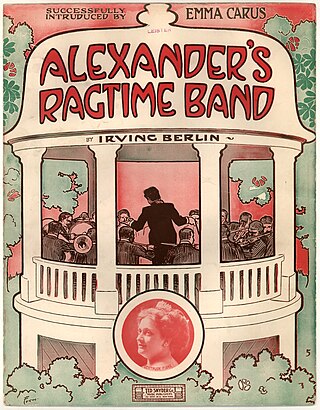Top Qs
Timeline
Chat
Perspective
Screen Songs
Series of animated cartoons From Wikipedia, the free encyclopedia
Remove ads
Screen Songs (formerly known as KoKo Song Car-Tunes) are a series of animated cartoons produced at the Fleischer Studios and distributed by Paramount Pictures between 1929 and 1938.[1] Paramount brought back the sing-along cartoons in 1945, now in color, and released them regularly through 1951. Two of Paramount's one-shot cartoons quietly revived the format later: Candy Cabaret (1954) and Hobo's Holiday (1963).
This article needs additional citations for verification. (August 2022) |

Remove ads
History
Summarize
Perspective
The Screen Songs are a continuation of the earlier Fleischer series Song Car-Tunes in color. They are sing-along shorts featuring the famous "bouncing ball", a sort of precursor to modern karaoke videos.[2] They often featured popular melodies of the day. The early Song Car-Tunes were among the earliest sound films, produced two years before The Jazz Singer. They were largely unknown at the time because their release was limited to the chain of 36 theaters operated by The Red Seal Pictures Company, which was equipped with the early Lee DeForest Phonofilm sound reproduction equipment. The Red Seal theater chain—formed by the Fleischers, DeForest, Edwin Miles Fadiman, and Hugo Riesenfeld—went from the East Coast to Columbus, Ohio.
Between May 1924 and September 1926, the Fleischers released 36 Song Car-Tunes series, with 19 using the Phonofilm sound-on-film process. The films included Oh Mabel, Come Take a Trip in My Airship, Darling Nelly Gray, Has Anybody Here Seen Kelly?, and By the Light of the Silvery Moon. Beginning with My Old Kentucky Home (1926), the cartoons featured the "follow the bouncing ball" gimmick, that lead the audience singing along with the film. The other 17 films in the Song Car-Tunes series were silent, designed to be shown with live music in movie theaters.
The Fleischers were ahead of the sound revolution, and just missed the actual change when Red Seal Pictures filed for bankruptcy in the fall of 1926.
Remove ads
Releases after Red Seal Pictures
In 1928, the Weiss Brothers reissued through their Artclass Pictures company and other independent distributors a number of the silent "Ko-Ko Song Car-tunes" with new animation created for the beginnings, removing the original titles and opening original footage.
- For Me and My Gal (1926)
- I Love to Fall Asleep (1926)
- In My Harem (1926)
- Just Try to Picture Me (1926)
- My Sweetie (1926)
- Old Pal (1926)
- Alexander's Ragtime Band (1926)
- The Sheik of Araby (1926)
- Annie Laurie (1926)
- Oh! How I Hate to Get Up in the Morning (1926)
- When I Lost You (1926)
- Margie (1926)
- When the Midnight Choo-Choo Leaves for Alabam' (1926)
- Oh! What a Pal Was Mary (1926)
- Everybody's Doing It (1926)
- Yak-A-Hula-Hick-A-Doola (1926)
- My Wife's Gone to the Country (1926)
- My Old Kentucky Home (1926)
- Beautiful Eyes (1926)
- Finiculee Finicula (1926)
- Micky (1926)
- When the Angelus Was Ringing (1926)
- When I Leave This World Behind (1926)
- Tumbledown Shack in Athlone (1927)
- The Rocky Road to Dublin (1927)
- Call Me Up Some Rainy Afternoon (1927)
- Oh I Wish I Was in Michigan (1927)
Remove ads
New contract with Paramount Pictures
The Fleischers signed a new contract with Paramount Pictures in late 1928. Beginning in February 1929, the song cartoons returned under a new name, Screen Songs, using the Western Electric sound-on-film process. The first was The Sidewalks of New York (East Side, West Side) released on 5 February 1929. In the 1930s, the shorts began to feature such musical guest stars as Lillian Roth, Ethel Merman, Cab Calloway, Rudy Vallée, The Mills Brothers, the Boswell Sisters, and others. The series, which eventually focused on many of the "Big Bands" of "The Swing Era" continued until 1938. In 1945, Famous Studios, successors to the Fleischers, revived the Screen Songs as an all animated series. The earliest Screen Song released as part of the Noveltoons series, When G.I. Johnny Comes Home, was released on February 2, 1945.[3]
Filmography
Summarize
Perspective
Fleischer Studios
Famous Studios
"Start your day with a song and sing the whole day through. Even while you're busy working, do just like the birdies do! Though the day may be long, you never will go wrong. Off-key, on-key, any old key, just start your day with a song!"
— Opening to the Famous Studios Screen Song shorts.
For all the shorts, the musical arrangements were made by Winston Sharples.
Remove ads
See also
Notes
- First Screen Song short in the Paramount Picture series.
- First two Screen Song shorts featuring Buzzy the Crow in the Paramount Picture series.
- Only Screen Song short with only a picture cameo appearance of Little Audrey.
- Only Screen Song short featuring the fishes from McElligot's Pool, based on the book by Dr. Seuss in the Paramount Picture series.
- Only Screen Song short featuring Herman in the Paramount Picture series.
- Only Screen Song short featuring the ghosts from Casper the Friendly Ghost in the Paramount Picture series.
- First Harveytoon short in the Paramount Picture series and first Screen Song/Harveytoon short reissued by Harvey Films.
Remove ads
References
External links
Further reading
Wikiwand - on
Seamless Wikipedia browsing. On steroids.
Remove ads
